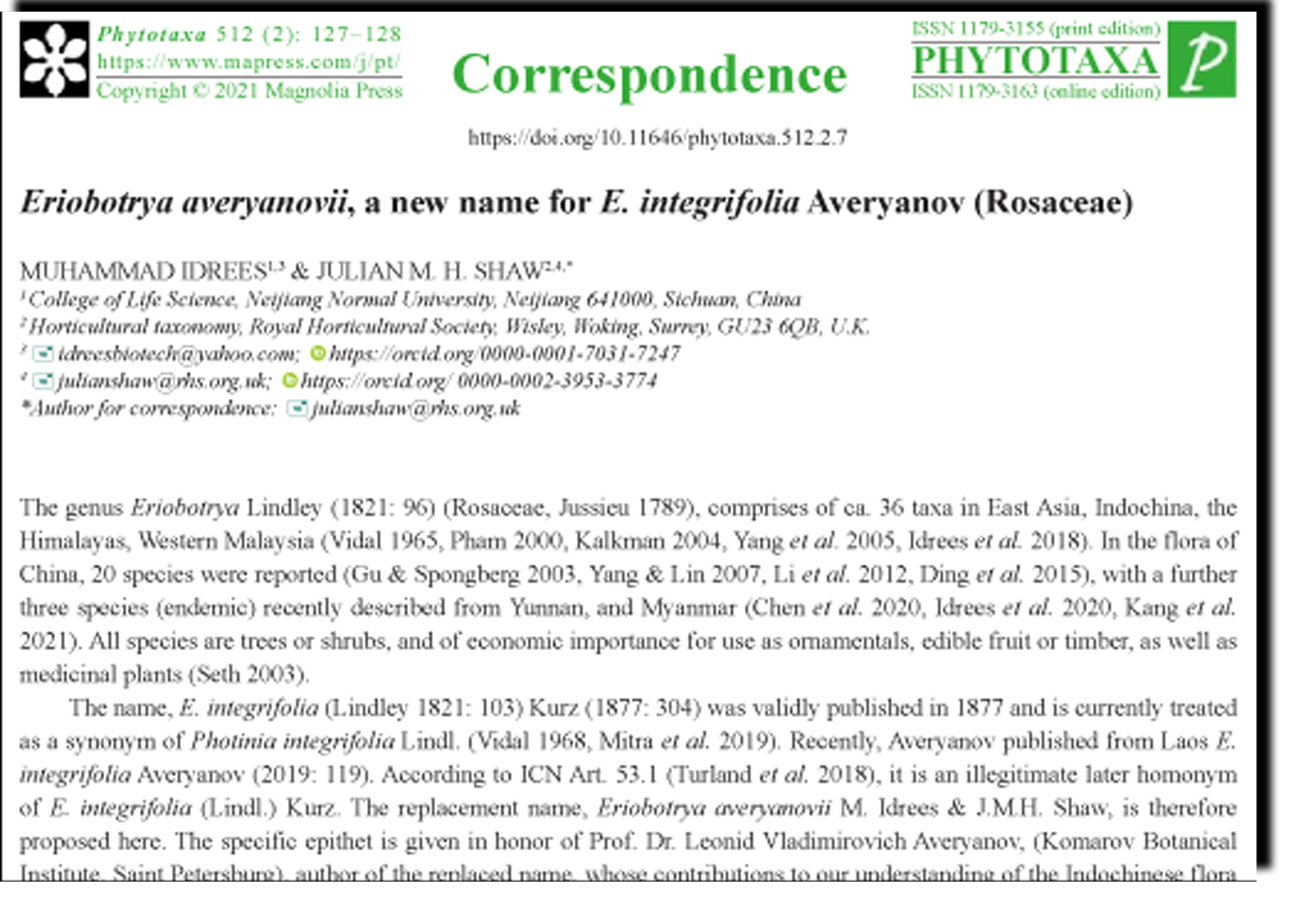Abstract
The genus Eriobotrya Lindley (1821: 96) (Rosaceae, Jussieu 1789), comprises of ca. 36 taxa in East Asia, Indochina, the Himalayas, Western Malaysia (Vidal 1965, Pham 2000, Kalkman 2004, Yang et al. 2005, Idrees et al. 2018). In the flora of China, 20 species were reported (Gu & Spongberg 2003, Yang & Lin 2007, Li et al. 2012, Ding et al. 2015), with a further three species (endemic) recently described from Yunnan, and Myanmar (Chen et al. 2020, Idrees et al. 2020, Kang et al. 2021). All species are trees or shrubs, and of economic importance for use as ornamentals, edible fruit or timber, as well as medicinal plants (Seth 2003).
References
<p>Averyanov, L.V. (2019) Rosaceae. In: Averyanov, L.V., Nguyen, K.S. & Maisak, T. (Eds.) Plant diversity, flora and vegetation of Hin Nam No National Protected Area: Plant Communities and Plant Species Diversity of Hin Nam No National Protected Area. Lap Lambert Academic Publishing, pp. 118–119.<br>Chen, S.F., Meng, K.K., Guo, X.B., Zhao, W.Y., Liao, W.B. & Fan, Q. (2020) A new species of Eriobotrya (Rosaceae) from Yunnan Province, China. Phytokeys 146: 61–69. https://doi.org/10.3897/phytokeys.146.50728<br>Ding, M.Y., Fan, Q., Guo, W., Shi, S. & Liao, W.B. (2015) Valid publication of the name Eriobotrya × daduheensis (Malinae, Rosaceae). Phytotaxa 212 (1): 95–98. https://doi.org/10.11646/phytotaxa.212.1.5<br>Gu, C.Z. & Spongberg, S.A. (2003) Eriobotrya Lindl. In: Wu, Z.Y., Raven, P.H., Hong, D.Y. (Eds.) Flora of China, Vol. 9 (Pittosporaceae through Connaraceae. Science Press, Beijing & Missouri Botanical Garden Press, St. Louis, pp. 46–434.<br>Idrees, M., Do, T.V. & Gao, X.F. (2018) A new species of Eriobotrya (Rosaceae) from Con Dao National Park, southern Vietnam. Phytotaxa 365 (3): 288–294. https://doi.org/10.11646/phytotaxa.365.3.6<br>Idrees, M., Mitra, L.P. & Gao, X.F. (2020) Eriobotrya fusca sp. nov. (Rosaceae) from Yunnan Province, China. Bangladesh Journal of Botany 49: 1077–1084. https://doi.org/10.3329/bjb.v49i4.52542<br>Jussieu, A.L. de (1789) Classis XIV, Ordo X (Rosaceae, Les Rosacees). In: Jussieu, A.L. (Ed.) Genera plantarum, secundum ordines naturales disposita, juxta methodum in Horto regio parisiensi exaratam, anno M.DCC.LXXIV. Apud viduam Herissant et Theophilum Barrois, Parisiis, pp. 334–344. https://doi.org/10.5962/bhl.title.284<br>Kang, D.H., Homervergel, G.O., Lee, J.H., Jung, E.K., Kyaw, N.O., Fan, Q. & Kim, Y.D. (2021) A new broad-leaved species of loquat from eastern Myanmar and its phylogenetic affinity in the genus Eriobotrya (Rosaceae). Phytotaxa 482 (3): 279–290. https://doi.org/10.11646/phytotaxa.482.3.6<br>Kalkman, C. (2004) Rosaceae. In: Kubitzki, K. (Ed.) The Families and Genera of Vascular Plants. VI Flowering Plants-Dicotyledons Celastrales, Oxalidales, Rosales, Cornales, Ericales. Springer, Berlin, pp. 138–141. https://doi.org/10.1007/978-3-662-07257-8_39<br>Kurz, S. (1877) Rosaceae: Eriobotrya Lindl. In: Kurz, S. (Ed.) Contribution towards a knowledge of the Burmese Flora. J. Asiat. Soc. Bengal, Pl. 2, Nat. Vol. XLV. Bishop’s College Press, Calcutta, pp. 304–305.<br>Lindley, J. (1821) Observation on the natural group of plants called Pomaceae. Transaction of the Linnean Society of London 13: 88–106. https://doi.org/10.1111/j.1095-8339.1821.tb00058.x<br>Li, F.F., Li, Q.Y., Cui, D.F. & Liao, W.B. (2012) Eriobotrya fulvicoma (Rosaceae), a new species from Guangdong Province, China. Annals Botanica Fennici 49 (4): 263–266. https://doi.org/10.5735/085.049.0408<br>Mitra, L.P., Idrees, M., Gao, Y.D. & Gao, X.F. (2019) A taxonomic revision of Photinia integrifolia (Rosaceae). Phytotaxa 401 (3): 179–189. https://doi.org/10.11646/phytotaxa.401.3.3<br>Newman, M., Ketphanh, S., Svengsuksa, B., Thomas, P., Sengdala, K., Lamxay, V. & Armstrong, K. (2007) A checklist of the Vascular Plants of Lao PDR. Royal Botanic Garden Edinburgh.<br>Pham, H.H. (2000) Rosaceae. In: Pham, H.H. (Ed.) Cây cỏ Việtnam: An illustrated Flora of Vietnam, vol.1. Young Publishing House, Ho Chi Minh City, pp. 778–808. <br>Seth, M.K. (2003) Trees and their economic importance. The Botanical Review 69: 321–376. https://doi.org/10.1663/0006-8101(2004)069[0321:TATEI]2.0.CO;2<br>Turland, N.J., Wiersema, J.H., Barrie, F.R., Greuter, W., Hawksworth, D., Herendeen, P.S., Knapp, S., Kusber, W.H., Li, D.-Z., Marhold, K., May, T.W., McNeill, J., Monro, A.M., Prado, J. Price, M.J. & Smith, G.F. (editors) (2018) International Code of Nomenclature for algae, fungi, and plants (Shenzhen Code) adopted by the Nineteenth International Botanical Congress Shenzhen, China, July 2017. Koeltz Botanical Books, Glashütten. https://doi.org/10.12705/Code.2018<br>Vidal, J.E. (1965) Notes sur quelques Rosacees asiatiques (III). Revision du genre Eriobotrya (Pomoideae). Adansonia 5: 537–580.<br>Yang, X.H., Glakpe, K., Lin, S.Q., Hu, Y.L., He, Y., Nguyen, T.C.N., Liu, Y., Hu, G.B. & Liu, C.M. (2005) Taxa of genus Eriobotrya plants around the world and specializing Southeastern Asia. Journal of Fruit Science 22: 55–59.<br>Yang, X.H. & Lin, S.Q. (2007) The identity of Eriobotrya kwangsiensis Chun, sp. n. Acta Horticulturae 750: 221–224. https://doi.org/10.17660/ActaHortic.2007.750.34</p>


